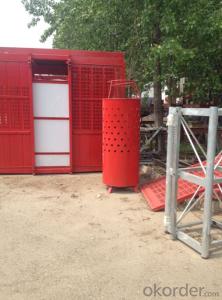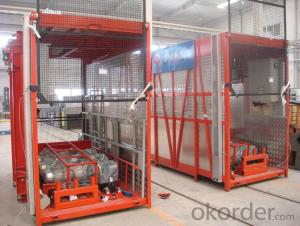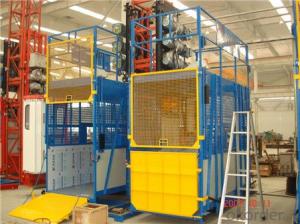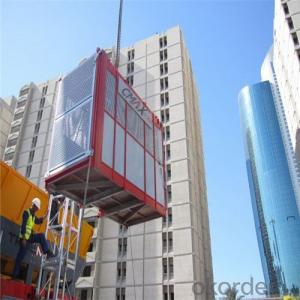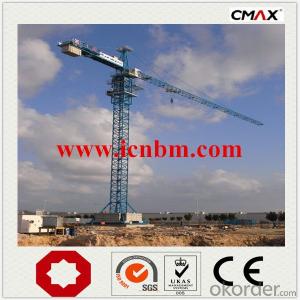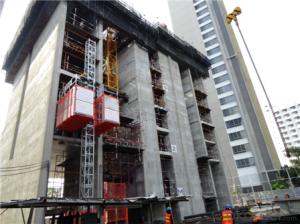Construction Machinery Building CMAX Hoists Cranes
- Loading Port:
- China main port
- Payment Terms:
- TT OR LC
- Min Order Qty:
- 1 set
- Supply Capability:
- 1000 set/month
OKorder Service Pledge
OKorder Financial Service
You Might Also Like
Specification
SC200/200 3*2*11kw building electric hoist
Descriptions of our building hoist:
SC100 construction hoist is a new generation product designed by construction mechanization research, Chinese Academy of Architecture. It is of high technology and of high safety, convenient to maintain, is an ideal Vertical transport tool for modern building .
Main Features of Building Material Hoist
1. the recommended cage dimension(LXWXH):2.0X1.0X2.5, 2.5X1.0X2.5, 2.5X1.3X2.5, 3.0X1.5X2.5, 3.2X1.5X2.5, 3.8X1.5X2.5, 4.0X1.5X2.5, 4.2X1.5X2.5 etc, we can also manufacture cages of other size according to the user.
2. The cage and the door material can be aluminum molded board, punched-plate, figured aluminum board or other type according to your requirements.
3. The mast and the tie-in surface can adopt paint-spray, or hot galvanizeing processing.
Advantage of our building hoist:
1. Our own systems of production engineering.
2. Production design from the concept to the engineering details.
3. Technical experts with great experience in the sector.
4. Continuous development of new solutions and products adapted to the requirements of our clients.
5. Methodology and project procedure administration in compliance with current guidelines.
6. Extensive worldwide commercial network
Specification of our building hoist:
Characteristic | Model | Rated Loading | Lifting Speed | Motor Power |
Double cabin | SC200/200 | 2×2000kg | 33m/min | 2×(3×11kw) |
SC150/150 | 2×1500kg | 33m/min | 2×(2×15kw) | |
SC100/100 | 2×1000kg | 33m/min | 2×(2×11kw) | |
Single cabin | SC200 | 2000kg | 33m/min | 3×11kw |
SC150 | 1500kg | 33m/min | 2×15kw | |
SC100 | 1000kg | 33m/min | 2×11kw |
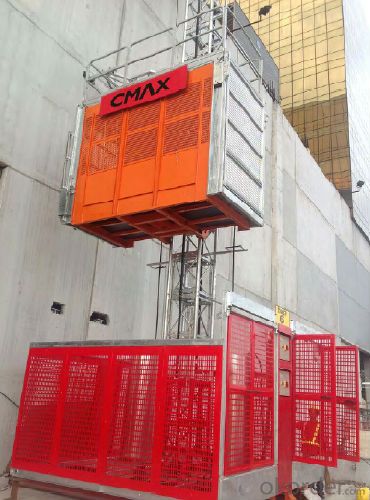
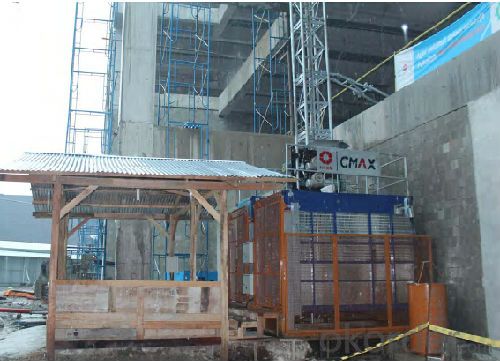


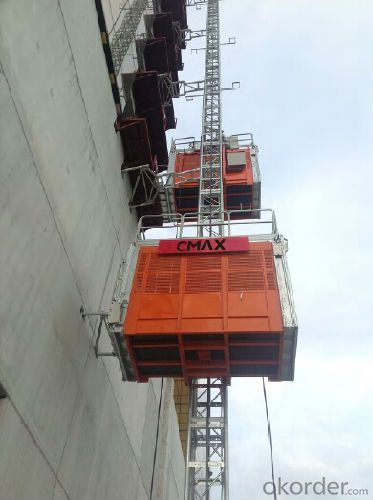
Production line
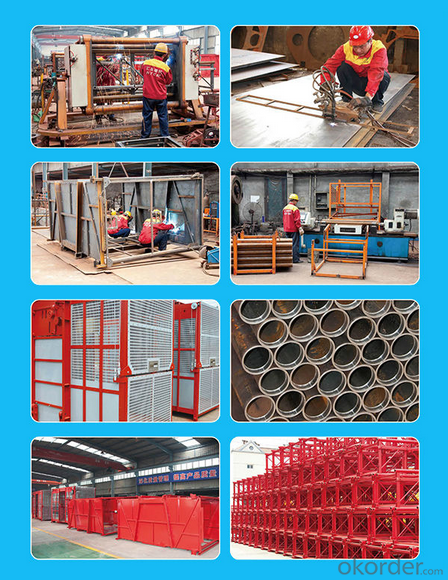
FAQ
1. why chose us?
China National Building Materials (Group) Corporation (CNBM), established in 1984,now is one of the largest state-owned group corporation in China, dealing with building materials & industrial equipment. Up to year 2010, CNBM Group's total asset is 20 billion USD and total staff is more than 100,000.CNBM International Corporation, specializes in designing & manufacturing of various
kinds of construction machinery, including tower crane, building hoist, etc. All the equipment produced by CNBM are compliant with the National level quality standard, and wins great reputation for their endurable performance in worldwide markets.
2.How about the shipment?
You can put 2 sets of of wheel loaders in one 40HQ container. The spare parts are packed with boxes.
The delivery time is 20 days.
3. What about your service?
We have our factory, we can meet customers needs as soon as possible.
We have first rate professional technology and provide good after-sales service.
4.After Sales Service
We offer the Preventative Maintenance and After Sales Service. For we strongly feels about the importance of supporting our customers and the product solutions we provide. Consequently we offer comprehensive maintenance options to prevent equipment issues before they become problems. Also we offer one year guarantee period.
- Q: Does the misuse or incorrect use of lifting equipment pose a risk of injury to workers?
- <p>Yes, improper or incorrect use of lifting equipment can cause serious injury to workers. This can include accidents such as dropping loads, which can lead to crushing injuries or being struck by falling objects. Additionally, improper lifting techniques can lead to musculoskeletal injuries, such as back strains or sprains. It's crucial for workers to be trained in the safe operation of lifting equipment and to follow all safety protocols to minimize the risk of injury.</p>
- Q: This question asks if a building hoist can be utilized for the purpose of lifting heavy objects.
- <p>Yes, a building hoist is specifically designed for lifting heavy objects in construction settings. It is a mechanical device that can lift and lower materials such as concrete, bricks, and tools to various levels of a building under construction. Building hoists are engineered to handle substantial weight and are equipped with safety features to ensure secure and efficient operation. However, it is crucial to adhere to the hoist's weight capacity and safety guidelines to prevent accidents and ensure the proper use of the equipment.</p>
- Q: This question asks for guidance on selecting an appropriate building hoist for construction purposes.
- <p>To choose a suitable building hoist, consider the following: 1) Capacity: Ensure the hoist can handle the weight of materials to be lifted. 2) Construction site conditions: Choose a hoist that fits the site's dimensions and layout. 3) Safety features: Opt for a hoist with safety mechanisms like overload protection and emergency stop. 4) Maintenance: Select a hoist that requires minimal maintenance to reduce downtime. 5) Cost: Compare prices and consider the total cost of ownership, including maintenance and operation. 6) Manufacturer reputation: Choose a reputable manufacturer for quality and after-sales support. 7) Compliance: Ensure the hoist meets local safety regulations and standards. Always consult with a hoist expert or the manufacturer for specific advice tailored to your project's needs.</p>
- Q: This question asks for the method to determine the maximum load that a single-rope lift can handle.
- <p>To calculate the load capacity of a single-rope lift, you need to consider several factors including the strength of the rope, the diameter of the rope, the angle of the lift, and the safety factor. The basic formula involves determining the maximum load the rope can bear based on its material properties and construction, which is then adjusted by the safety factor to account for dynamic loads and potential wear. The formula might look something like this: Load Capacity = (Tensile Strength of Rope 脳 Area of Rope Cross-Section 脳 Safety Factor) / (Cosine of Angle of Incline). It's important to consult with engineering standards and the lift manufacturer's specifications for precise calculations.</p>
- Q: This question asks about the routine maintenance procedures for a building hoist, which is a piece of equipment used in construction to lift materials and personnel.
- <p>To maintain a building hoist, follow these steps: Regularly inspect the hoist for any signs of wear or damage, especially the cables, pulleys, and safety mechanisms. Lubricate moving parts as per the manufacturer's guidelines to reduce friction and prevent rust. Ensure all safety features, such as emergency stops and limit switches, are functioning correctly. Keep the hoist clean and free from debris, which can interfere with its operation. Check the electrical connections for any signs of corrosion or damage. Perform load tests to confirm the hoist's lifting capacity and ensure it meets safety standards. Always follow the manufacturer's maintenance schedule and guidelines, and have a professional service the hoist periodically.</p>
- Q: The maximum allowable deviation of the vertical is the vertical degree when the construction elevator is installed
- The maximum allowable deviation for the installation of the elevator rail frame is the following: The height of the elevator rail is less than 70 meters, and the vertical deviation should not be greater than one thousandth of the height of the guide frame. 2, the guide frame height is greater than 70 meters is less than or equal to 100 meters, the deviation is less than or equal to 70 mm. 3, the guide frame is larger than 100 meters is less than 150 meters, the deviation is less than or equal to 90 mm. 4, the guide frame is larger than 150 meters is less than or equal to 200 meters. The deviation is less than or equal to 110 mm. The guide frame is greater than 200 meters and the deviation is less than 130 mm.
- Q: This question asks for a comparison between electric and electric-hydraulic building hoists, highlighting their distinct features and how they differ from each other.
- <p>Electric building hoists are powered solely by electric motors, which provide direct and precise control over the lifting and lowering of loads. They are quieter, require less maintenance, and are more energy-efficient compared to their hydraulic counterparts. On the other hand, electric-hydraulic building hoists combine the power of an electric motor with the force amplification capabilities of hydraulic systems. These hoists offer greater lifting capacity and can handle heavier loads but are generally more complex, requiring regular maintenance of hydraulic components. They are also louder and may consume more energy. The choice between the two often depends on the specific requirements of the lifting task, such as load capacity, precision, and environmental considerations.</p>
- Q: This question asks for a description of the process of using a hydraulic cylinder in the context of a building hoist.
- <p>To use a hydraulic cylinder in a building hoist, first ensure the hoist is properly installed and secured. Connect the hydraulic cylinder to the hoist's power source, typically a hydraulic pump. The pump pressurizes hydraulic fluid, which is then directed into the cylinder. As the fluid enters, it pushes a piston within the cylinder, causing it to extend and lift the load. To lower the load, the fluid is released from the cylinder, allowing the piston to retract. Always monitor the pressure and ensure the system is leak-free for safe operation. Regular maintenance, including checking seals and lubricating parts, is crucial to prolong the life of the hydraulic cylinder and ensure efficient hoist performance.</p>
- Q: This question asks for a guide on how to properly and effectively install lifting equipment to ensure safety and efficiency.
- <p>To install lifting equipment safely and efficiently, follow these steps: 1. Ensure the equipment is suitable for the load and environment. 2. Check all safety features and documentation. 3. Position the equipment on a stable, level surface. 4. Follow the manufacturer's installation guide precisely. 5. Conduct a thorough inspection before operation. 6. Train operators on safe usage. 7. Regularly maintain and inspect the equipment. Remember, safety is paramount, and adherence to guidelines is crucial to prevent accidents and ensure efficient operation.</p>
- Q: Is it possible to utilize a building hoist for elevating construction materials at construction sites?
- <p>Yes, building hoists are commonly used for lifting materials at construction sites. They are designed to transport heavy construction materials and personnel vertically, which is essential for multi-story construction projects. These hoists are equipped with safety features and are operated by trained personnel to ensure the secure and efficient movement of materials and workers.</p>
Send your message to us
Construction Machinery Building CMAX Hoists Cranes
- Loading Port:
- China main port
- Payment Terms:
- TT OR LC
- Min Order Qty:
- 1 set
- Supply Capability:
- 1000 set/month
OKorder Service Pledge
OKorder Financial Service
Similar products
Hot products
Hot Searches
Related keywords
